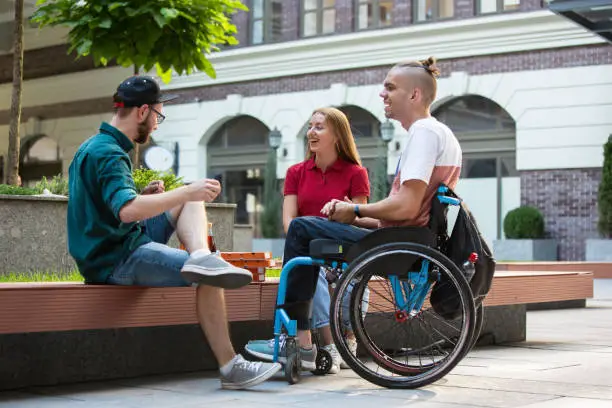If you or someone you love is living with a disability in Texas, finding the resources to help maintain a safe, functional, and accessible home can be a challenge. Fortunately, free home repair programs are available to assist individuals with disabilities, ensuring they can live independently and comfortably.
This guide will walk you through everything you need to know about free home repair for the disabled in Texas, from understanding the programs to applying for assistance and ensuring your home meets your needs.
What Are Free Home Repair Programs for the Disabled?
Free home repair programs for the disabled in Texas are designed to provide financial assistance and resources to individuals who need home modifications or repairs to improve accessibility and safety.
These programs target low-income residents and often focus on improving essential services like plumbing, electrical systems, or wheelchair ramps to make homes more accessible for people with disabilities.
These programs are funded by both the federal government and private organizations, including non-profits and local governments, that are committed to helping people with disabilities live in dignity. These repairs are often needed to address health and safety issues, improve mobility, and ensure that disabled individuals can fully enjoy their homes.
Why Are These Programs So Important?
- Improved Quality of Life: A well-maintained and accessible home significantly improves the quality of life for individuals with disabilities. It promotes independence, reduces the risk of injury, and creates a supportive living environment.
- Financial Relief: Many individuals with disabilities live on fixed incomes. Free repairs can save substantial out-of-pocket costs, allowing families to allocate resources to other essential needs.
- Health and Safety: Aging homes or those not adapted for disabilities can pose risks such as falls, injuries, or health hazards. Repairs and modifications ensure that homes are safer and more comfortable.
According to the U.S. Census Bureau, nearly 15% of the American population lives with some form of disability, highlighting the widespread need for accessible living spaces. In Texas alone, over 3 million residents live with disabilities, many of whom could benefit from these vital programs.
Types of Home Repairs Covered Under These Programs
When applying for free home repairs for the disabled in Texas, the types of services covered by these programs can vary, but some of the most common repairs include:
- Wheelchair Ramps and Lifts: One of the most common needs for people with mobility impairments is the installation of wheelchair ramps or lifts to ensure they can enter and exit their homes safely.
- Bathroom Modifications: This may include the installation of grab bars, accessible showers, or wheelchair-accessible sinks to ensure the bathroom is safe and functional for those with physical disabilities.
- Roof and Structural Repairs: If your roof or foundation is damaged, some programs offer repair services to ensure that the home is secure and weather-resistant.
- Electrical and Plumbing Repairs: Many low-income residents require electrical or plumbing repairs that can be expensive to fix on their own. Programs may assist with necessary repairs that keep homes running safely.
- General Safety Improvements: Some programs cover minor repairs such as fixing stairs, doorways, windows, or replacing unsafe flooring.
- Accessibility Enhancements: In addition to ramps, modifications might include widening doorways, installing stairlifts, or adding handrails in hallways. These enhancements make everyday navigation easier and safer.
Key Resources and Programs in Texas
In Texas, several resources are available to help individuals with disabilities get free home repair assistance. Here are some key programs to consider:
1. The Texas Department of Housing and Community Affairs (TDHCA)
The TDHCA offers programs specifically for homeowners with disabilities, including the Housing Assistance Program and Home Repair and Rehabilitation Programs. These programs are designed to help individuals with low-income households get the repairs and modifications they need.
- Eligibility: Generally, these programs are available to Texas residents who meet low-income criteria and have a disability.
- Application Process: You can apply for assistance through local Community Action Agencies (CAA) that manage these funds and programs. You may need to provide proof of income, disability status, and the need for repairs.
- Success Rates & Impact: Thousands of Texans have benefited from these programs, with improvements in home safety and accessibility directly linked to higher rates of independent living.
- Key Link: Texas Department of Housing and Community Affairs
2. Texas Ramp Project
The Texas Ramp Project is a non-profit organization dedicated to providing wheelchair ramps to people in need across the state. They have a network of volunteers who construct ramps at no cost to qualified individuals.
- Eligibility: The program is available for Texans with mobility issues who have no other means to pay for a ramp.
- Application Process: Individuals can apply by filling out an online application, which will then be reviewed by the organization. Ramps are generally built in areas where volunteers are available.
- Impact: Since its inception, the project has delivered thousands of ramps, dramatically improving mobility and independence for many individuals.
- Key Link: Texas Ramp Project
3. The Home Modification Loan Program (HMLP)
Offered by the TDHCA, the Home Modification Loan Program provides low-interest loans to low-income homeowners who need to make modifications for accessibility reasons. While this program isn’t strictly “free,” it offers affordable financing options for those who need more significant modifications and may not qualify for other programs.
- Eligibility: Homeowners must meet certain income guidelines and own their home in order to qualify.
- Application Process: You can apply online through the TDHCA’s website or through a local agency that administers this program.
- Benefits: Even though it’s a loan, low-interest terms make it a practical solution for homeowners needing extensive modifications they otherwise couldn’t afford.
- Key Link: Home Modification Loan Program
4. Rebuilding Together Houston
This non-profit organization helps individuals in Houston and the surrounding areas with free home repairs. They focus on safety, health, and accessibility, helping elderly and disabled homeowners stay in their homes longer.
- Eligibility: Homeowners who meet income and age requirements, as well as those who have disabilities, are eligible for assistance.
- Application Process: Applications can be submitted online, and applicants will need to provide income verification and documentation of their disability.
- Impact: According to their website, Rebuilding Together Houston has helped thousands of families by repairing homes that were previously unsafe or inaccessible.
- Key Link: Rebuilding Together Houston
5. Habitat for Humanity Texas
While Habitat for Humanity is widely known for its new home construction, many local chapters across Texas also provide repair services to homeowners with disabilities. These repairs often focus on making homes safer and more accessible.
- Eligibility: Habitat for Humanity programs often prioritize homeowners with disabilities and elderly individuals.
- Application Process: Visit the website of your local Habitat for Humanity chapter to find out more about their repair programs and application process.
- Community Impact: Habitat for Humanity projects often involve community volunteers, fostering strong community ties while supporting homeowners in need.
- Key Link: Habitat for Humanity Texas
How to Apply for Free Home Repair Assistance
Applying for free home repair programs typically involves the following steps:
- Research Programs: Review available programs in your area to determine which ones are a good fit for your needs. Use the links provided above to explore the different organizations.
- Complete the Application: Each program has its own application process, which may include submitting documents like proof of income, disability status, homeownership, and details about the repairs needed. Make sure to complete the forms carefully and provide all necessary information.
- Submit Your Application: Once you have completed the application, submit it according to the instructions on the program’s website. Be prepared to wait for approval, as some programs have long waiting lists.
- Follow Up: If you haven’t heard back after a few weeks, follow up with the program administrators to check the status of your application.
- Get the Repairs Done: If you’re approved, contractors or volunteers will begin the repair work. Make sure to stay in contact to ensure the process is moving smoothly.
Preparing for the Application Process
- Documentation: Gather all necessary documents before starting your application. This may include:
- Proof of disability (doctor’s statement, disability card, etc.)
- Income verification (pay stubs, tax returns, etc.)
- Homeownership proof (deed, property tax statement)
- Photos or assessments detailing the repairs needed
- Seek Assistance: If you’re overwhelmed by paperwork, many non-profits offer assistance with filling out forms. Local community centers or senior service agencies can also help guide you through the process.
Additional Tips for Homeowners with Disabilities
- Consult Local Resources: Many counties and municipalities in Texas also offer home repair assistance, so don’t hesitate to ask local government offices about available resources. For example, local Community Development Corporations (CDCs) often have specific programs tailored to community needs.
- Consider Alternative Funding: If you don’t qualify for these programs, consider applying for grants or low-interest loans from organizations like the Texas Veterans Commission, which also offers assistance to disabled veterans in need of home repairs. Grants.gov is another resource for finding applicable federal grants that can help fund repairs.
- Look for Volunteer Groups: Many local church groups and civic organizations volunteer to help individuals with disabilities by providing free labor to complete home repairs. These volunteer efforts can be a great way to access help without cost.
- Maintenance: Once you receive repairs, regular maintenance can prevent further issues. Keep an eye on wear and tear, and address small repairs promptly to avoid larger, more costly problems later.
Real-Life Success Stories
To bring this information to life, consider these real-life stories:
Case Study 1: Sarah’s Accessible Home Transformation:
Sarah, a wheelchair user in Dallas, struggled to navigate her two-story home. Through the Texas Ramp Project and additional assistance from Rebuilding Together Houston, she received a wheelchair ramp, widened doorways, and installed a stairlift. These modifications allowed Sarah to move independently and increased her quality of life. Her story is a testament to how free home repair programs can make a profound difference.
Case Study 2: Mark’s Bathroom Modifications:
Mark, who lives with a spinal cord injury in Austin, faced many challenges in his outdated bathroom. After applying for assistance through the TDHCA, he was able to install an accessible shower, grab bars, and a lowered sink. These simple modifications not only improved safety but also enabled him to maintain personal hygiene independently, preserving his dignity and autonomy.
Data, Sources, and Further Reading
- U.S. Census Bureau: For statistics on disability demographics in Texas, visit the U.S. Census Bureau.
- Texas Department of Housing and Community Affairs: Detailed info on eligibility, programs, and application processes at TDHCA.
- National Association of Home Builders (NAHB): They provide insights on accessibility standards and guidelines which may be helpful for understanding what modifications are best suited for different disabilities.
- Center for Housing Policy: For further reading on housing programs and policy changes that benefit disabled homeowners.
Why You Should Apply Now
If you’re living with a disability and need home repairs, time is of the essence. Many of these programs have limited funding and may operate on a first-come, first-served basis. Additionally, repairs can be costly if not addressed early, so applying for assistance sooner rather than later ensures you get the help you need without risking your health and safety.
Subscribe to Grant Writing Academy Newsletter for More Resources
Are you looking to enhance your chances of getting assistance for home repairs or other needs?
Subscribe to the Grant Writing Academy Newsletter! Gain access to expert tips, strategies, templates, and tools to improve your success rates in applying for grants, including home repair programs. Whether you’re an individual with a disability or a nonprofit working to assist others, we’ve got the resources you need to thrive.
Our newsletter covers:
- Tips and Best Practices: Learn how to write compelling grant proposals that stand out.
- Strategies and Templates: Access customizable templates to streamline your grant writing process.
- Tools and Resources: Discover new tools that can simplify data collection, budgeting, and project planning for home repair programs and more.
- Success Stories: Read about others who have successfully navigated grant applications and learned how to replicate their success.
Visit Grant Writing Academy and subscribe today! By subscribing, you’ll not only learn how to secure funding but also stay informed about upcoming workshops, webinars, and community forums where you can connect with like-minded individuals and experts in the field.
Additional Resources and Support
a) Expand Your Knowledge
The grant writing field is always evolving. Keep learning and improving your skills to stay competitive.
Recommended Resources:
- Request for Proposal Success: How to Write Proposals That Win: Learn the techniques and strategies to create standout proposals.
- Tech Startup Funding Secrets: Navigating Grants for Maximum Growth: Perfect for those in the tech sector looking to leverage grants for scaling.
- Grant Proposal Guide for Environmental Projects: Tailored for environmental initiatives seeking to secure impactful funding.
- The Ultimate Guide to Federal Grant Applications: Techniques for Success: Master the complexities of federal grants with actionable insights.
Explore More Books Here
b) Invest in Expert Guidance
Want to fast-track your growth and achieve even more success?
Join one of our mentorship programs for tailored advice and support:
Mentorship Programs:
- 3-Month Mentorship: The Foundation Builder: A short-term plan to refine your grant writing skills and win your first (or next) grant.
- 6-Month Mentorship: The Proposal Pro: Dive deeper into strategies, proposal reviews, and funding plans.
- 1-Year Mentorship: The Funding Champion: Build long-term success with comprehensive guidance, unlimited reviews, and exclusive resources.
C) Book a One-on-One Consultation
Sometimes you just need personalized advice to tackle challenges or fine-tune your strategy. Let’s work together to solve your unique grant writing challenges.
Book a Consultation Call Here
Final Thoughts
Navigating the world of home repairs when living with a disability can be daunting, but remember that help is available. Texas offers numerous programs aimed at making homes safer and more accessible for disabled residents.
Remember, taking the first step can open doors to a safer and more comfortable living environment, enhancing your independence and improving quality of life. Don’t let fear of paperwork or uncertainty hold you back—use the resources available, reach out for help, and empower yourself to make the changes you need.
Your home should be a sanctuary, not a source of stress. Let these free home repair programs pave the way for a brighter, safer future.






